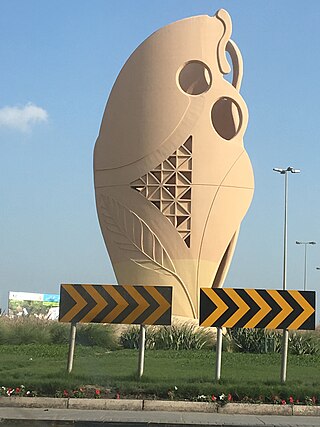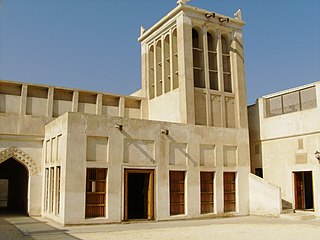
Dilmun, or Telmun, was an ancient East Semitic-speaking civilization in Eastern Arabia mentioned from the 3rd millennium BC onwards. Based on contextual evidence, it was located in the Persian Gulf, on a trade route between Mesopotamia and the Indus Valley civilisation, close to the sea and to artesian springs. Dilmun encompassed Bahrain, Kuwait, and eastern Saudi Arabia. This area is certainly what is meant by references to "Dilmun" among the lands conquered by King Sargon II and his descendants.

Failaka Island is a Kuwaiti Island in the Persian Gulf. The island is 20 km off the coast of Kuwait City in the Persian Gulf. The name "Failaka" is thought to be derived from the ancient Greek φυλάκιο(ν) – fylakio(n) "outpost".

The Bahrain National Museum is the largest and oldest public museum in Bahrain. It is situated in Manama, adjacent to the National Theatre of Bahrain. Opened on 15 December 1988 by the Emir of Bahrain Isa bin Salman Al Khalifa, the $30 million museum complex covers 27,800 sq meters and is the country's most popular tourist attraction. It is believed to be the region's first modern museum.

The Dilmun Burial Mounds are a UNESCO World Heritage Site comprising necropolis areas on the main island of Bahrain dating back to the Dilmun and the Umm al-Nar culture.

A'ali is a major town in northern Bahrain. It is a part of the Northern Governorate, although from 2001 to 2014 it lay within the Central Governorate. A'ali is famous for its ancient burial mounds, especially several very large burial mounds in the city centre. A'ali is also famous for its traditional handcrafted pottery, which can be seen and bought from different potters and boutiques in the whole town.

The Barbar Temple is an archaeological site located in the village of Barbar, Bahrain, considered to be part of the Dilmun culture. The most recent of the three Barbar temples was rediscovered by a Danish archaeological team in 1954. A further two temples were discovered on the site with the oldest dating back to 3000 BC. The temples were built of limestone blocks, believed to have been carved out from Jidda Island.
Diraz is the biggest and most populated village on the northwest coast of Bahrain. It lies to the east of Budaiya, west of Barbar and north of Bani Jamra. Two Dilmun era archaeological sites, namely Diraz Temple and Ain Umm Sujoor, and Ain Umm Aldajaj are located in this village. Duraz is also known for its people's unique Bahraini dialect which can be easily recognized as it is quite different from its neighbouring villages.

The following outline is provided as an overview of and topical guide to Bahrain:
Jidda Islands are a group of three small uninhabited islets in Bahrain, lying to the west of Bahrain Island and just north of Umm an Nasan in the Persian Gulf. They are 17.5 km (10.9 mi) west of the capital, Manama, on Bahrain Island.

Barbar is a village in the north of Bahrain. Situated in the Northern Governorate, it lies between the neighbouring villages of Diraz and Jannusan, along the Budaiya highway.

The Qal'at al-Bahrain, also known as the Bahrain Fort or Portuguese Fort, is an archaeological site located in Bahrain. Archaeological excavations carried out since 1954 have unearthed antiquities from an artificial mound of 12 m (39 ft) height containing seven stratified layers, created by various occupants from 2300 BC up to the 18th century, including Kassites, Greeks, Portuguese and Persians. It was once the capital of the Dilmun civilization and was inscribed as a UNESCO World Heritage Site in 2005.

The Bahrain Pearling Path is a serial cultural heritage site inscribed on the UNESCO World Heritage List on June 30, 2012. It consists of three oyster beds in the northern waters of Bahrain, a segment of the coast and the seafront Bu Mahir fort in the southern tip of Muharraq Island, and 17 buildings in historical section of Muharraq connected by a 3.5 km visitor pathway.
Ikaros was the Hellenistic name for what is now the Failaka Island of Kuwait. It is located 50 kilometres (31 mi) southeast of the spot where the Tigris and Euphrates empty into the Persian Gulf. For thousands of years, the island served as a strategic point in the Persian Gulf that would enable its ruler to control the lucrative trade that passed through the area; the island has been a strategic location since the rise of the Sumerian city-state of Ur in Mesopotamia.
The World Heritage Earthen Architecture Programme (WHEAP) is a UNESCO initiative promoting earthen architecture founded in 2007 and running till 2017.

Archaeology of Qatar as a field study began in 1956. Three major expeditions were carried out in Qatar throughout the mid-20th century, with the first being launched by a Danish team who began work in the 1950s. This was followed by British and French expeditions in 1970s and 1980s, respectively. Approximately 200 archaeological sites were discovered during these expeditions, with the most extensive being the coastal areas of Al Da'asa, Ras Abrouq and Al Khor Island. Artifacts such as flint tools, Ubaid and Barbar pottery and encampments were found in situ.
The UAE's Iron Age I spanned 1,200–1,000 BCE; Iron Age II, 1,000–600 BCE and Iron Age III from 600–300 BCE. This was followed by the Hellenistic Mleiha era, from 300 BCE onwards through to the Islamic era which commenced with the culmination of the 7th century Ridda Wars.
















